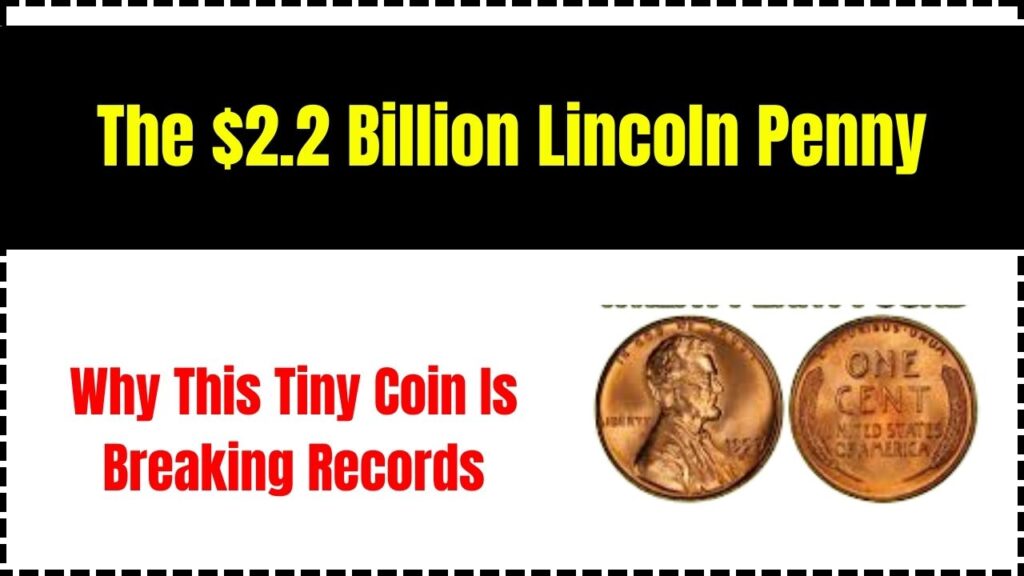The $2.2 Billion Lincoln Penny: Have you ever looked at a penny and wondered if it might be worth more than just one cent? You’re not alone—and you’re certainly not the first. The concept of a $2.2 billion Lincoln penny has recently taken the internet by storm, prompting both seasoned coin collectors and curious newcomers to take a second look at their spare change. While this jaw-dropping figure sounds too fantastical to be true (and spoiler alert: it is), there’s a fascinating story behind this little copper coin that continues to captivate collectors, investors, and historians alike.

In this comprehensive guide, we’ll explore why this penny has captured such intense public attention, debunk the myths surrounding its so-called billion-dollar price tag, and provide expert insights into how to identify and evaluate potentially valuable coins. Whether you’re a novice coin collector, a history buff, or just someone who loves a good treasure hunt, this article is for you.
The $2.2 Billion Lincoln Penny
| Feature | Details |
|---|---|
| Coin in Focus | Lincoln Wheat Penny |
| Year Mentioned | 1943 (Bronze Error Coins) |
| Estimated Value of Rarest Penny | $1.7 million source |
| Most Valuable Known Variant | 1943-D Bronze Penny (Only one known to exist) |
| Fact-Check | No penny has sold for $2.2 billion |
| Popular Auction House | Heritage Auctions official site |
| Authentication Services | PCGS, NGC |
| Collectible Trend | Increasing interest in rare U.S. coins since 2020 |
| Noteworthy Resource | American Numismatic Association for education and community |
The viral hype about a $2.2 billion Lincoln penny might be fiction, but the enthusiasm it generates is very real. Whether you’re drawn to the thrill of discovery, the joy of collecting, or the potential for investment, coin collecting offers a uniquely rewarding experience. While no known penny has sold for billions, some—like the 1943-D bronze cent—have indeed changed lives.
Keep your eyes open. That humble penny in your change jar just might have a historic story—and a surprising value—behind it.
The Lincoln Penny: A Quick History
The Lincoln cent, first minted in 1909, holds the distinction of being the first U.S. coin to feature a real person: President Abraham Lincoln. This marked a significant shift in American coinage, which previously featured more abstract figures like Lady Liberty. Designed by Victor David Brenner, the original Lincoln penny included the famous “V.D.B.” initials on the reverse, which sparked public debate and led to their temporary removal.
The Lincoln Wheat Penny—so named because of the wheat stalks on its reverse side—was produced from 1909 to 1958. These coins were replaced by the Lincoln Memorial reverse in 1959, in honor of Lincoln’s 150th birthday. Even decades later, the Wheat Penny remains one of the most collectible U.S. coins due to its nostalgic design, historical importance, and availability in circulation.
Why Is the Lincoln Penny Suddenly Worth Billions?
Let’s clear up the confusion. No Lincoln penny has ever been sold for $2.2 billion. That number appears to be a hyperbolic internet rumor, likely based on clickbait headlines or fictional portrayals. However, there’s still truth behind the buzz: certain rare Lincoln pennies have sold for astonishing amounts—some fetching upwards of $1 million.
The Real Treasure: The 1943 Bronze Penny Error
In 1943, amid the resource demands of World War II, the U.S. Mint shifted penny production from copper to zinc-coated steel to preserve copper for military needs. But not every coin followed protocol. A handful of pennies were accidentally struck on leftover bronze planchets from the previous year. These rare mistakes became legendary among coin collectors.
Most Valuable 1943 Variants:
- 1943-D Bronze Penny: Minted in Denver, this is the only known example of its kind. It reportedly sold for $1.7 million.
- 1943-S Bronze Penny: Minted in San Francisco, it’s another ultra-rare find, sold at auction for around $1 million.
- 1943 Bronze (Philadelphia Mint): These coins are more frequently found than the D and S mint versions but still extremely rare. Value ranges from $250,000 to over $1.5 million, depending on condition and certification.
What Makes a Coin Valuable?
Determining the value of a coin isn’t just about its age. Experts, known as numismatists, evaluate coins using several professional criteria:
1. Rarity
Coins with limited mintage or few surviving examples fetch higher prices. A coin with only one known specimen, like the 1943-D Bronze Penny, is essentially priceless in the right auction setting.
2. Mint Errors
Mistakes during the minting process can lead to coins with unusual features. Examples include double die errors, off-center strikes, and incorrect metal compositions. These imperfections can make coins more desirable to collectors.
3. Condition (Grade)
Coin grading is a professional system that ranges from Poor (P-1) to Perfect Mint State (MS-70). Coins with no signs of wear, even under magnification, are far more valuable. Agencies like PCGS and NGC are industry leaders in this field.
4. Historical and Cultural Significance
Coins associated with major events—like wartime changes, presidential anniversaries, or design overhauls—tend to carry additional value. They appeal not just to collectors, but also to museums and institutions.
Check if Your Penny Is Valuable: A The $2.2 Billion Lincoln Penny Guide
Here’s how you can find out if the penny jingling in your pocket could be worth a fortune:
- Examine the Date and Mint Mark:
- Look for tiny letters under the year: “D” for Denver, “S” for San Francisco, and no mark for Philadelphia.
- Notable years include 1909-S VDB, 1914-D, 1922 Plain, 1943 (bronze), and 1955 Doubled Die.
- Try the Magnet Test: Grab a magnet. A genuine 1943 steel penny will stick; a bronze one won’t. If your 1943 penny doesn’t stick, you may be holding a rare error coin.
- Assess Condition Under Magnification:
- Use a jeweler’s loupe or magnifying glass.
- Look for sharp details, no scratches, and even color tone. Mint State coins are highly sought-after.
- Get a Professional Grade:
- Submit your coin to a reputable grading company like PCGS or NGC.
- A graded coin receives a certification and encapsulated case for protection and legitimacy.
- Seek a Trustworthy Buyer or Auction House:
- Work with certified dealers and reputable auction platforms.
- Examples include Heritage Auctions, GreatCollections, and Stack’s Bowers.
Collecting Lincoln Pennies: A Growing Trend
Coin collecting isn’t just for hobbyists—it’s also becoming a savvy financial move. In recent years, the market for rare U.S. coins has surged. According to data from the American Numismatic Association, collector membership and market participation has increased by over 10% from 2020 to 2023.
What’s Fueling the Boom?
- Nostalgia: People love reconnecting with history through everyday items.
- Accessibility: You can start collecting with just a few dollars.
- Education: Coin collecting teaches attention to detail, history, economics, and even metallurgy.
- Investment Potential: Rare coins can outperform traditional assets like stocks or gold.
Families are also using coin collecting as a fun, intergenerational activity. Grandparents pass down coins, stories, and life lessons to younger generations.
These 7 Rare $2 Bills Could Be Worth Thousands in 2025 – Do You Have One?
Lincoln Wheat Penny Worth $4.2 Million — Have You Checked Your Coins Yet?
1777 George III Five Guinea Coin Worth $340,000: Do You Own One?
FAQs On The $2.2 Billion Lincoln Penny
Is there really a $2.2 billion Lincoln penny?
No. This is a myth, likely born from online exaggeration. No documented sale or listing has come close to that figure.
What’s the most expensive penny ever sold?
The 1943-D Bronze Lincoln Penny, which sold for $1.7 million, holds the current record.
How do I know if my 1943 penny is valuable?
Do the magnet test first. Then, compare the coin’s weight and color to known bronze examples. If in doubt, send it for grading.
Where should I sell a rare penny?
Choose professional outlets like Heritage Auctions or coin conventions. Online marketplaces like eBay can work, but only with authentication.
Can newer pennies be worth money?
Yes. Look for modern errors like the 1992 Close AM or 1983 Double Die Reverse. Some are worth hundreds or even thousands of dollars.








